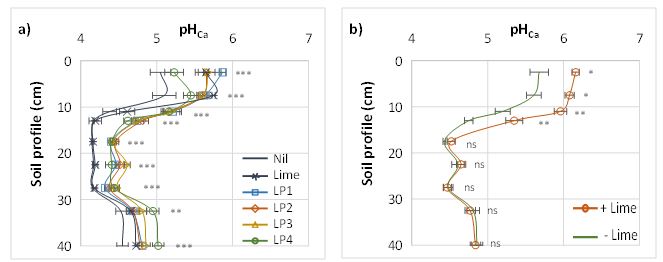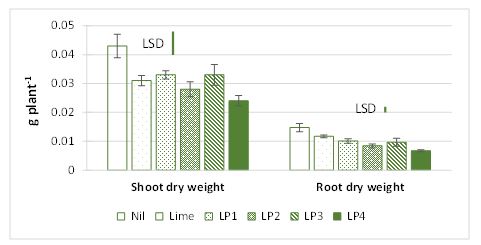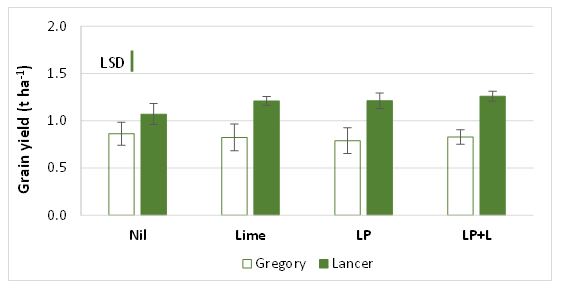Effects of surface incorporation of organic matter (lucerne pellets) on subsurface soil acidity and wheat growth
Take home messages
- Results from glasshouse experiments indicated that the surface incorporation of an organic matter, such as lucerne pellets, can increase subsurface soil pH.
- The combined incorporation of lucerne pellets with lime could improve the ameliorating effect of the organic amendment on subsurface soil acidity.
- However, in a first-year field experiment, the incorporation of lucerne pellets with lime only affected the pH in soil layer 5cm below the incorporated layer and did not improve grain yield.
Background
In Australia, acidic soil affects many major crops such as wheat, barley, canola and pulses. Surface incorporation of lime can increase the pH of the 10-20cm subsurface soil layer, but the rate of change is very slow (0.04 pH units per year) (Liet al. 2019). Subsurface soil acidity can also be ameliorated by the incorporation of organic amendments (Butterlyet al. 2013). The pH increases by the addition of organic matter is a consequence of the association reactions between hydrogen ions and organic anions, decarboxylation of organic anions and ammonification of organic nitrogen (N) compounds. Moreover, organic matter is able to detoxify the Al3+ by forming organic acid-Al complexes. The aim of this research was to study the effects of surface incorporation of organic matter on subsurface soil pH and plant growth.
Glasshouse Experiment 1
This experiment was conducted at Charles Sturt University, Wagga Wagga, in November 2015. Soil samples were collected from the top 40cm in layers (i.e. 0-10cm, 10-20cm, 20-30cm and 30-40cm) near Holbrook, NSW. The soil was classified as Yellow Chromosol (Isbell, 1996). The initial pH was 4.54, 4.15, 4.46 and 5.15 in the soil layer 0-10cm, 10-20cm, 20-30cm and 30-40cm, respectively. The soil profile was reconstructed into a pot which was built from PVC pipe (10cm diameter and 50cm length), maintaining the order and thickness of each layer, except for the 30-40cm layer which occupied 17cm at the bottom of the pot. Fine ground lucerne or lime was incorporated in layers from 0-30cm by single or double or triple layers. The acid soil sensitive wheat variety Axe (Australian Grain Technologies Pty Ltd, Glen Osmond, SA) was grown and the shoot and roots dry biomass and soil pH of each layer were determined at 31 days after sowing.
Key results from Glasshouse Experiment 1
No improvement on either shoot or root biomass was detected in any of the treatments, even though the wheat variety Axe is considered sensitive to soil acidity. Lucerne incorporation resulted in a significant (P<0.05) reduction of shoot and root growth compared to the lime treatment and this effect was exacerbated if the lucerne was placed in the top soil layers.
However, the incorporation of lucerne or lime significantly increased pH (P<0.05) (Table 1). The lime treatment increased pH where lime was placed, whereas lucerne treatments raised pH not only at the depth where it was placed, but also below the incorporated layers (Table 1). The more depths to which lucerne were incorporated, the greater the pH increased below the depths where amendment was placed (Table 1).
Table 1. Effect of placement of lime and ground lucerne pellet (LP) amendments on mean pH in CaCl2 of soil layers of reconstructed soil columns of acidic soil at 31 days of the experiment.
Soil layer (cm) | Soil layer placement of lime or ground lucerne pellet (LP) | ||||||||||||||
|---|---|---|---|---|---|---|---|---|---|---|---|---|---|---|---|
Control | 1st layer | 2nd layer | 3rd layer | 1st and 2nd layers | 1st and 3rd layers | 2nd and 3rd layers | 1st, 2nd and 3rd layers | ||||||||
None | lime | LP | lime | LP | lime | LP | lime | LP | lime | LP | lime | LP | Lime | LP | |
1st (0-10) | 4.6 | 5.2* | 5.1* | 4.6 | 4.6 | 4.6 | 4.6 | 5.1* | 5.5* | 5.1* | 5.2* | 4.6 | 4.6 | 5.2* | 5.5* |
2nd (10-20) | 4.2 | 4.2 | 4.5* | 5.4* | 5.5* | 4.2 | 4.2 | 5.4* | 5.7* | 4.2 | 4.8* | 5.4* | 5.7* | 5.4* | 5.8* |
3rd (20-30) | 4.2 | 4.2 | 4.4 | 4.2 | 4.5* | 4.7* | 5.4* | 4.2 | 4.9* | 4.6* | 6.0* | 4.7* | 6.0* | 4.7* | 6.2* |
4th (30-40) | 4.4 | 4.4 | 4.6* | 4.4 | 4.6* | 4.4 | 4.6 | 4.4 | 4.9* | 4.4 | 4.9* | 4.4 | 4.9* | 4.5 | 5.5* |
* = indicates significant differences (LSD = 0.196, at P<0.05) of a pairwise means comparison of the pH between the layer of the control pot (unamended layers pot) and the corresponding layer of the amended pots — where not indicated, it is not significantly different. This LSD value is a conservative statistic for pairwise means comparisons across soil layers and treatment combinations.
Glasshouse Experiment 2
Soil samples were collected at the Ferndale site at Dirnaseer, west of Cootamundra, NSW. The soil was classified as red chromosol (Isbell, 1996). The initial pH was 4.83, 4.18, 4.12 and 4.62 in soil layer 0-10cm, 10-20cm, 20-30cm and 30-40cm, respectively. The soil profile was reconstructed as described in Experiment 1. The lucerne pellets were cut into ~2cm (LP1), ~1cm (LP2), ~0.5cm (LP3) and 0.1-0.2cm (LP4) and incorporated into the top 5cm of soil column, whereas lime was incorporated into the top 10cm. For treatments with the combination of lucerne pellets and lime, the incorporated depths were kept the same. An acid soil resistant wheat variety Dart (LongReach Plant Breeders Management Pty Ltd, VIC, SA) was used in this experiment. Shoot, root dry weight and soil pH were measured at 14, 21, 28 and 35 days after sowing.
Key results from Glasshouse Experiment 2
The incorporation of lucerne pellet into the top 5cm soil layer significantly increased soil pH throughout the soil column (downward to 40cm), particularly in the fine cut lucerne treatments, whereas the incorporation of lime alone only increased pH at the incorporated layer (0-10cm — Figure 1a). Furthermore, the combination of lucerne with lime raised the pH more than lucerne alone (Figure 1b). The pH of the soil layer from 0-15cm in lucerne pellets + lime treatment increased by 0.47-0.76 pH unit compared to lucerne pellets treatment alone (Figure 1b). Lime might have reacted with acidity in the incorporated layer, which provided more available alkali from the lucerne pellets to move downward.
Figure 1. The pH profile at 14 days after sowing - (a) the pH of the soil incorporated with no addition of amendment (Nil); lime; lucerne pellets ~2cm, ~1cm, ~0.5cm, and 0.1-0.2cm (LP1, LP2, LP3, and LP4, respectively); (b) the pH of the soil incorporated with LP3 in combination with (+Lime) and without (-Lime) lime; *** = P<0.001; **= P<0.01; * = P<0.05; ns = not significant (P>0.05); closed vertical bars indicated standard error (n=4)
The incorporation of the lucerne pellets had a negative effect on plant growth up to 28 days after sowing, but no significant differences were observed at 35 days after sowing. Both shoot and root dry weight of the treatments with addition of the amendments were significantly lower than the control (nil) treatment after 14 days of sowing (Figure 2). The ground lucerne pellets ~0.1-0.2cm (LP4) had adverse effects on both shoot and root growth compared with the other lucerne pellets sizes (Figure 2). Shoot and root dry weight in LP4 treatment decreased by 37.5% and 43.3% compared with shoot and root dry weight in the LP3 treatment, respectively. The results of this experiment were similar to those found in Experiment 1.
Figure 2. Shoot and root dry weight of single plant at 14 days after sowing. Closed horizontal bars indicated standard error (n=4); opened horizontal bar indicated the least significant difference (LSD) at P=0.05.
Field experiment
A field experiment was established in 2018 at a Ferndale site at Dirnaseer, west of Cootamundra, NSW, (34o38’S, 147o49’E). The experiment was a split-plot design with two wheat varieties as main plots and four soil amendment treatments as subplots, replicated four times. The four treatments were no addition of the amendment (Nil); addition of 2.5t/ha lime (Lime); addition of 15.0t/ha lucerne pellets ~0.5cm (LP) and, addition of 15.0t/ha lucerne pellets ~0.5cm in combination 2.5t/ha lime (LP+L). The amendments were incorporated into ~5cm of the soil profile. The two wheat varieties were an acid soil sensitive variety, Lancer (LongReach Plant Breeders Management Pty Ltd, VIC, SA) and the acid soil resistant variety Gregory (Queensland Department of Primary Industries and Fisheries (DPI&F) within the Enterprise Grains Australia (EGA)). Soil pH was measured before, at three months, six months after incorporation and at harvest time at depths of 0-5cm, 5-10cm, 10-15cm, 15-20cm, 20-30cm and 30-40cm. Grain yield was measured with quadrat cut.
Key results from field experiment
The incorporation of the amendments significantly increased pH at the incorporated layer, however it had no effect on pH of the layer below 5cm of the soil profile three months after incorporation. At harvest, however, the pH in the 5-10cm layer of the soil profile significantly increased following treatment with lime and LP+L (Figure 3). No pH change was detected below 10cm of the soil profile.
Figure 3. The pH profile at harvest (eight months after incorporation). *** = P<0.001, ** = P<0.01 and ns = not significant (P>0.05). Nil = control treatment with no addition of the amendment, Lime = treatment with lime, LP = treatment with lucerne pellets, and LP+L = treatment with lucerne pellets in combination with lime. Closed vertical bars indicated standard error (n=8).
Grain yield did not increase from any soil amendment for either acid soil sensitive or resistant wheat varieties in the first year of the experiment (Figure 4). However, on average across the treatments, the grain yield of the acid soil sensitive variety was significantly higher than the grain yield of the resistant variety (Figure 4).
Figure 4. The field grain yield of acid soil resistant and sensitive varieties, GregoryA and LancerA, respectively. Closed horizontal bars indicated standard error (n=4); opened horizontal bar indicated the least significant difference (LSD) at P=0.05.
Conclusions
Surface incorporation of lucerne pellets ameliorated subsurface acidity under controlled glasshouse conditions. The pH of the subsurface layers increased higher with the surface incorporation of organic matter in combination with lime. Although the incorporation of the amendments increased soil pH, plant growth in the glasshouse and field grain yield did not significantly improve in the short term.
References
Butterly, C. R.; Baldock, J. A. and Tang, C. 2013. The contribution of crop residues to changes in soil pH under field conditions. Plant and Soil, 366: 185-198.
Isbell, R. F. 1996. The Australian Soil Classification, CSIRO Publishing, Melbourne.
Li, G. D.; Conyers, M. K.; Heylar, K. R.; Lisle, C. J.; Poile, G. J. and Cullis, B. R. 2019. Long-term surface application of lime ameliorates subsurface soil acidity in the mixed farming zone of south-eastern Australia. Geoderma, 338: 236-246.
Acknowledgements
The research undertaken as part of this project is made possible by the significant contributions of growers through both trial cooperation and the support of the GRDC — the author would like to thank them for their continued support.
Thanks to Richard Lowrie and Adam Lowrie (DPI NSW technical staff) for assistance in the field work, and Grace Kaveney, Jordan Bathgate and Matthew Champness for help in soil sampling. Special thanks to the Ministry of Agriculture and Rural Development, Vietnam, for the PhD scholarship for Hoang Han Nguyen.
Contact details
Hoang Han Nguyen
School of Agriculture and Wine Sciences, Charles Sturt University, Wagga Wagga NSW
0468462014
hnguyen@csu.edu.au
GRDC Project Code: DAN00206,
Was this page helpful?
YOUR FEEDBACK




